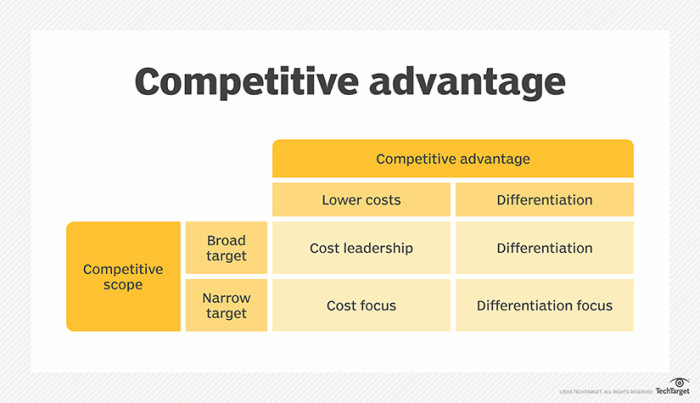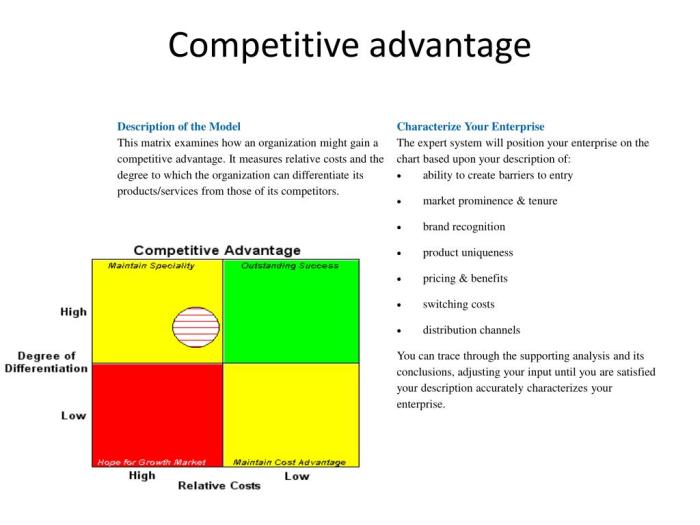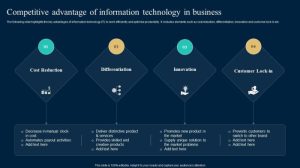
Understanding your company’s competitive advantage is crucial for sustained success in today’s dynamic market. This assessment goes beyond simply identifying what makes your company unique; it involves a deep dive into your internal capabilities, external competitive landscape, and market positioning. By systematically analyzing these factors, you can pinpoint strengths to leverage, weaknesses to address, and opportunities to exploit for growth.
This process, while requiring careful consideration, ultimately empowers you to make informed strategic decisions and achieve a competitive edge.
This guide provides a structured approach to evaluating your company’s competitive position. We will explore various frameworks, from analyzing core competencies and conducting SWOT analyses to measuring key performance indicators (KPIs) and understanding market segmentation. The goal is to equip you with the tools and knowledge necessary to not only assess your current competitive advantage but also to develop strategies for enhancing and sustaining it over the long term.
Defining Competitive Advantage

A competitive advantage is what sets a company apart from its rivals, allowing it to achieve superior performance and profitability. It’s not simply about being better; it’s about creating and sustaining value that competitors find difficult to replicate or surpass. This advantage can stem from various sources, ultimately leading to a more sustainable market position and increased returns. Understanding the nature of competitive advantage is crucial for strategic planning and long-term success.
Competitive advantages are broadly categorized into three main types: cost leadership, differentiation, and niche market focus. Each strategy leverages different aspects of a company’s capabilities and market positioning to achieve a sustainable edge.
Cost Leadership
Cost leadership involves becoming the lowest-cost producer in an industry while offering comparable products or services. This strategy requires efficient operations, economies of scale, and a focus on cost reduction in all aspects of the business. Companies pursuing this strategy often target a broad market segment, aiming to capture significant market share through price competitiveness. Walmart, for example, has successfully implemented a cost leadership strategy through its efficient supply chain management, bulk purchasing power, and streamlined operations, allowing it to offer lower prices than many competitors.
Another example is McDonald’s, which utilizes standardized processes and economies of scale to maintain low costs and offer affordable meals.
Differentiation
Differentiation involves creating products or services that are perceived as unique and superior to those of competitors. This uniqueness can stem from various factors, including superior quality, innovative features, strong branding, excellent customer service, or a unique distribution network. Companies employing a differentiation strategy often charge premium prices, justifying the higher cost through the perceived value offered to customers.
Apple, with its innovative designs, user-friendly interfaces, and strong brand loyalty, is a prime example of a company that has successfully built a competitive advantage through differentiation. Similarly, luxury brands like Rolex and Gucci achieve differentiation through high-quality materials, craftsmanship, and exclusive brand image.
Niche Market Focus
A niche market strategy involves focusing on a specific, underserved segment of the market. Companies employing this strategy often develop specialized products or services tailored to the unique needs and preferences of their target customer group. This allows them to command premium prices or achieve higher margins due to reduced competition within their niche. Examples include companies specializing in organic food products, sustainable fashion, or high-end audio equipment.
A smaller, specialized company might focus on providing software solutions for a very specific industry, achieving a competitive advantage due to its deep understanding of that niche.
Identifying Core Competencies and Their Contribution to Competitive Advantage
Understanding a company’s core competencies is vital in defining and sustaining a competitive advantage. Core competencies are the unique skills and capabilities that allow a company to deliver superior value to its customers. These are often difficult for competitors to imitate and provide a foundation for competitive advantage. A framework for identifying core competencies might involve analyzing the following:
Firstly, assess the company’s resources and capabilities. This involves identifying tangible assets (e.g., equipment, technology, patents) and intangible assets (e.g., brand reputation, organizational culture, employee skills). Secondly, analyze the value chain to pinpoint activities where the company excels and creates significant value for customers. Finally, evaluate the sustainability of these capabilities. Can competitors easily replicate them?
Are they protected by patents or other barriers to entry? A company’s core competencies, when effectively leveraged, become the building blocks of its competitive advantage, whether it be cost leadership, differentiation, or niche market focus.
Assessing Internal Capabilities

Understanding your company’s internal strengths and weaknesses is crucial for identifying and leveraging your competitive advantage. A thorough assessment of internal capabilities allows you to pinpoint areas where you excel and areas needing improvement, ultimately informing strategic decision-making. This process involves examining your resources and capabilities within the context of your industry and competitive landscape.Identifying your company’s resources and capabilities requires a systematic approach.
This goes beyond simply listing assets; it’s about understanding how these resources interact to create value. Consider tangible assets like equipment and technology, as well as intangible assets such as brand reputation, intellectual property, and employee skills. Analyzing these resources through the lens of their contribution to competitive advantage helps prioritize areas for investment and development.
Value Chain Analysis
Value chain analysis provides a structured framework for evaluating internal strengths and weaknesses. By dissecting the various activities involved in creating and delivering a product or service, you can identify areas where your company adds value and where inefficiencies exist. This analysis considers all stages, from research and development to marketing and customer service. Identifying areas where your company’s processes are superior to competitors’ reveals a key source of competitive advantage.
For instance, a company with a highly efficient manufacturing process might enjoy lower costs and greater profitability, while a company with exceptional customer service might build stronger customer loyalty. Analyzing each stage of the value chain against competitors allows for a direct comparison of efficiency and effectiveness.
SWOT Analysis
A SWOT analysis provides a concise summary of your company’s internal and external factors. This framework helps synthesize the findings from your resource assessment and value chain analysis.
- Strengths: These are internal positive attributes that contribute to competitive advantage. Examples include a strong brand reputation, proprietary technology, a highly skilled workforce, efficient operations, or a strong financial position. For example, a company known for its superior customer service might list this as a strength.
- Weaknesses: These are internal negative attributes that hinder competitive advantage. Examples include outdated technology, a lack of skilled labor, inefficient processes, high costs, or a weak financial position. A company reliant on a single supplier might identify this as a weakness, making them vulnerable to supply chain disruptions.
- Opportunities: These are external factors that could benefit the company. Examples include emerging markets, technological advancements, changing consumer preferences, or government regulations. For instance, a growing demand for sustainable products presents an opportunity for companies to develop and market eco-friendly alternatives.
- Threats: These are external factors that could harm the company. Examples include increasing competition, economic downturns, changes in consumer preferences, or new regulations. A sudden increase in raw material costs would be considered a significant threat to a manufacturing company.
Evaluating Market Position
Understanding your company’s market position is crucial for developing a sustainable competitive advantage. This involves analyzing your market share, your standing relative to competitors, and a deep dive into your target market’s characteristics. By accurately assessing these factors, you can identify opportunities for growth and refine your strategies to maximize your competitive edge.A comprehensive evaluation of market position requires a detailed understanding of your company’s market share and how that share compares to your competitors.
This involves not only knowing the numerical value of your market share but also understanding the trends – is your share growing, shrinking, or remaining stagnant? Furthermore, a competitive analysis should identify the strengths and weaknesses of your main competitors, allowing you to pinpoint areas where you excel and where you might need improvement. This comparative analysis helps in formulating effective strategies to either maintain or improve your position within the market.
Target Market Characteristics
Defining your target market goes beyond simple demographics. It requires a detailed understanding of customer needs, preferences, buying behaviors, and psychographics. For example, a company selling high-end athletic wear might target affluent, health-conscious individuals aged 25-55 who value quality and performance. In contrast, a company selling budget-friendly clothing might focus on price-sensitive consumers of all ages. Understanding these nuances allows for more effective marketing and product development.
Market Position and Customer Segmentation
The following table summarizes the findings on market position and customer segmentation. This data is hypothetical and serves as an example of how to organize this information. In a real-world scenario, this data would be based on rigorous market research and analysis.
| Market Segment | Size (in millions of units) | Market Share (%) | Growth Potential (projected annual growth rate) |
|---|---|---|---|
| Premium Segment | 5 | 15% | 5% |
| Mid-Range Segment | 20 | 30% | 8% |
| Budget Segment | 35 | 55% | 3% |
Measuring Performance Metrics
Understanding and tracking the right performance metrics is crucial for evaluating your company’s competitive advantage. These metrics provide quantifiable data to support strategic decision-making and demonstrate the effectiveness of your competitive strategy. By consistently monitoring key indicators, businesses can identify areas of strength and weakness, facilitating proactive adjustments to maintain or enhance their competitive edge.Effective measurement requires a clear understanding of what constitutes success within your specific industry and market.
Simply choosing metrics because they are popular isn’t sufficient; the chosen metrics must directly reflect the aspects of your business that contribute to competitive advantage. This necessitates a close alignment between your competitive strategy and your performance measurement system.
Key Performance Indicators (KPIs) Relevant to Competitive Advantage
Selecting relevant KPIs requires a thorough understanding of your competitive strategy. For example, a company focused on cost leadership will prioritize metrics like production efficiency and operating margins. Conversely, a company pursuing differentiation might focus on brand awareness, customer satisfaction, and premium pricing. A business built on innovation might prioritize R&D spending, patent filings, and time-to-market for new products.
The key is to choose KPIs that directly reflect the elements of your competitive strategy.
Tracking and Analyzing KPIs Over Time
Once key KPIs are identified, consistent tracking and analysis are vital. This involves establishing a regular reporting schedule (e.g., monthly, quarterly) and using appropriate data visualization tools (e.g., charts, dashboards) to represent the data effectively. Trend analysis is particularly useful; identifying upward or downward trends in key metrics allows businesses to understand the impact of strategic initiatives and make necessary adjustments.
For instance, a consistent decline in customer satisfaction scores might indicate a need to improve customer service processes. Similarly, a steady increase in market share could suggest the success of a new marketing campaign.
Measuring Customer Satisfaction and its Correlation with Competitive Advantage
Customer satisfaction is a crucial indicator of competitive advantage. High customer satisfaction often translates to increased customer loyalty, positive word-of-mouth referrals, and higher willingness to pay premium prices. Measuring customer satisfaction can be done through various methods, including customer surveys (online, phone, email), feedback forms, and social media monitoring. The Net Promoter Score (NPS) is a widely used metric that measures customer loyalty and willingness to recommend a product or service.
A high NPS score generally indicates a strong competitive advantage. Analyzing customer feedback can reveal specific areas for improvement and inform decisions related to product development, customer service, and marketing strategies. For example, consistently negative feedback regarding a specific product feature might indicate a need for redesign or improvement. By proactively addressing customer concerns and improving satisfaction levels, companies can build a strong competitive advantage.
Developing Strategies to Enhance Competitive Advantage
Developing strategies to enhance competitive advantage involves a proactive approach to leveraging existing strengths, mitigating weaknesses, and capitalizing on market opportunities. This is not a static process; it requires continuous monitoring and adaptation to the ever-changing business landscape. Successful implementation requires a clear understanding of the company’s internal capabilities and external market dynamics, as previously discussed.This section details how to translate the assessment of your company’s competitive advantage into actionable strategies for growth and sustained success.
It focuses on turning insights into concrete plans for improvement and expansion.
Leveraging Existing Strengths
Identifying and leveraging existing strengths is crucial for enhancing competitive advantage. This involves focusing resources and efforts on areas where the company already excels. For example, a company with a strong brand reputation can leverage this asset through targeted marketing campaigns that highlight its trustworthiness and quality. Another company might possess superior technology, allowing it to develop innovative products or services that competitors cannot easily replicate.
This strength can be further enhanced through strategic investments in research and development to maintain a technological edge. A detailed analysis of your company’s SWOT (Strengths, Weaknesses, Opportunities, and Threats) analysis will help in identifying these key strengths. By systematically analyzing the performance of different aspects of your business, you can identify the areas that contribute the most to your success and focus on maximizing their impact.
Addressing Weaknesses and Mitigating Threats
Once weaknesses and external threats have been identified, strategies must be developed to address them. This might involve investments in training and development to improve employee skills, or strategic partnerships to gain access to necessary resources or expertise. For example, if a company’s weakness is a lack of efficient supply chain management, it could invest in new technologies or outsource certain logistical functions to a specialized provider.
If a major threat is increasing competition from a new market entrant, the company might respond by differentiating its products or services more sharply, focusing on niche markets, or lowering prices strategically. Effective mitigation strategies often require a combination of proactive measures and reactive responses to emerging challenges. This requires flexibility and adaptability in your business planning.
Capitalizing on Market Opportunities
Identifying and capitalizing on market opportunities is vital for strengthening a company’s competitive position. This involves proactively seeking out new markets, developing new products or services, or expanding into related business areas. For example, a company that notices a growing demand for sustainable products can develop a new line of eco-friendly offerings. Alternatively, a company with established distribution channels could leverage these assets to expand into new markets with complementary products.
Careful market research and analysis are essential for identifying promising opportunities and assessing their potential impact on the company’s bottom line. A well-defined market entry strategy is crucial for success, taking into account factors such as competition, consumer preferences, and regulatory requirements. A robust market research process, including both quantitative and qualitative data collection, is essential for making informed decisions.
Successfully assessing your company’s competitive advantage requires a multifaceted approach, combining internal analysis with a keen understanding of the external market. By leveraging the frameworks and strategies Artikeld in this guide – from identifying core competencies and conducting competitive analyses to tracking key performance indicators and adapting to market changes – you can gain valuable insights into your company’s strengths and weaknesses.
This comprehensive understanding will allow you to formulate effective strategies for enhancing your competitive position, ensuring sustained growth and success in a competitive environment. Remember, continuous monitoring and adaptation are key to maintaining a lasting competitive edge.
Expert Answers
What if my company lacks a clear competitive advantage?
Identify unmet customer needs or underserved market segments. Innovation and differentiation are key to creating a new advantage.
How often should I reassess my company’s competitive advantage?
Regular reassessment, ideally annually or even more frequently in rapidly changing markets, is crucial to stay ahead of the competition and adapt to evolving circumstances.
How can I measure customer satisfaction effectively?
Utilize surveys, feedback forms, and social media monitoring to gather customer opinions. Analyze this data to identify areas for improvement and track changes over time.
What role does innovation play in sustaining a competitive advantage?
Innovation is paramount. Continuous improvement, developing new products or services, and adapting to technological advancements are crucial for maintaining a long-term competitive edge.





